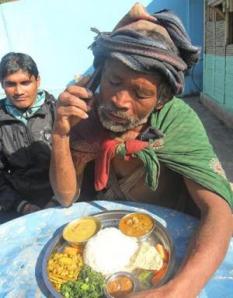Nepalgunj
 Rautes,
who have been living in forests for centuries, are now changing
their way of living. The standards of this nomadic tribe are also
improving with changes in their food and dressing. They had been living
in forests and eating forest edibles but are coming in contact with
other communities these days.
Rautes,
who have been living in forests for centuries, are now changing
their way of living. The standards of this nomadic tribe are also
improving with changes in their food and dressing. They had been living
in forests and eating forest edibles but are coming in contact with
other communities these days. They have started visiting town and market areas from forests. Unlike in the past, they have now begun living near settlement areas. They used to live in straw huts but now live in bamboo huts. Satyadevi Adhikari, Chairperson of Raute Development Foundation and also known as Rautes’ niece, says that Rautes are gradually changing.
‘When I first met them, they used to defecate standing up. They did not agree to sit for defecating, as that would require them to bow down. Later, I taught few women to sit to defecate without letting the Raute Chief know. After showing that those women were cleaner, I taught others too. Now they clean their hands with soap after defecation,’ Adhikari stated.
Mobile Craze
Rautes are getting drawn towards modern technologies. They enjoy talking on mobile phones when somebody lets them use it. A Raute Chief, Surya Narayan Shahi says that he feels delighted talking on mobile phones. When an outsider goes to a Raute community, he asks for the phone to call his acquaintances.
Towards Dependency
Rautes had been living by selling wooden goods but now are getting dependent on others after various organizations and government agencies are providing them with cash and food. Nepal’s government is providing them an allowance of NRs. 1,000 per month per person. Their daily life of trading wooden cases, containers and chests for food grains at the nearest settlement, collecting forest edibles and hunting wild animals is gradually changing. They have now started to come to towns and beg for money and food.
They ask money and even goats with anyone who goes to them for collecting information or undertaking studies or research. They spend money provided for allowance or as assistance by organizations on meat and alcohol. They even use the rice provided as food to make alcohol for their consumption. They beg for money with anyone who reaches their community.
Rautes used to eat wild roots (yam/beetroots) and meat of wild birds and monkey but now are drawn to having rice, goat meat and alcohol. Former Raute Chief, Maina Bahadur Shahi says prey (meat) is his favorite.
He says that their occupation of making wooden goods is now in risk due to allowance and other assistance. He states, ‘Rautes have stopped working after receiving allowances.’ He also adds that they cannot produce wooden goods because the villagers do not let them to cut tress in the forests.
Practice of Beating Paddy Disappearing
Rautes used to go to villages to exchange the wooden goods they produce for paddy and beating the paddy in mortar to make rice. However, the practice is now disappearing after government agencies and organizations began providing them with rice. Their traditional mortars have become toys for children.
For past few months, Rautes have been living along Jhupra River in Satakhani village of Surkhet district in far-western Nepal. Former Chief Shahi informed that they were preparing to move to Dailekh, an adjoining district, from there. He said, ‘Now we should move to Dailekh, Rautes should not stay at one place for long.’
Sensitive Towards Health

Recently, Rautes have gotten sensitive towards their health. They have started to bathe, comb their hair and wash their hands after eating. They have begun wearing sewn clothes and go to hospitals when they fall sick. Though they do not take medicine, they have started using treatment for injuries.
They go to hospitals when they get in street accidents. They only used to take medicinal herbs before. Dr. Suresh Kumar Kanaudiya, director of Nepalganj Medical College who has conducted health camps in Raute communities says that Raute youths are drawn to health check-ups.
Give Forests to Rautes
Though Rautes are undergoing changes in terms of visiting towns, eating goat meat, they do not agree to building and living in houses. A Raute Chief Aina Bahadur Raute says that they do not need houses. He says, ‘Rautes do not need houses, they live in forests.’ He adds that they also do not need citizenship.
Former Chief Maina Bahadur Raute demanded to give forests to the Rautes. He requested to create conditions where Rautes can live freely in forests – not houses. ‘Give Rautes the forests not houses,’ he said.
Democratic exercise among Rautes
Following rivalry among former Chiefs, Rautes have adopted democratic practice to appoint a Chief for each of their sub-group (clan). A gathering of all Rautes, held two months ago, has decided on three Chiefs through consensus for their three sub-groups – Kalyan, Raskoti and Samal. The gathering held in Satakhani village of Surkhet district picked Bir Bahadur, Dil Bahadur and Surya Narayan for Chiefs. Former Chief Maina Bahadur said, ‘After my resignation, we picked three Chiefs. I am an advisor now.’
Translated and adapted from original news report titled “बदलिँदै राउटे जीवनशैली” published on the Annapurna Post on above-mentioned date, available at http://annapurnapost.com/en/news/social/3742/%25E0%25A4%25AC%25E0%25A4%25A6%25E0%25A4%25B2%25E0%25A4%25BF%25E0%25A4%2581%25E0%25A4%25A6%25E0%25A5%2588-%25E0%25A4%25B0%25E0%25A4%25BE%25E0%25A4%2589%25E0%25A4%259F%25E0%25A5%2587%25E0%25A4%2595%25E0%25A5%258B-%25E0%25A4%259C%25E0%25A5%2580%25E0%25A4%25B5%25E0%25A4%25B6%25E0%25A5%2588%25E0%25A4%25B2%25E0%25A5%2580.htm
No comments:
Post a Comment